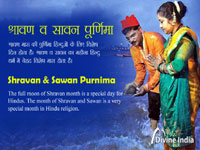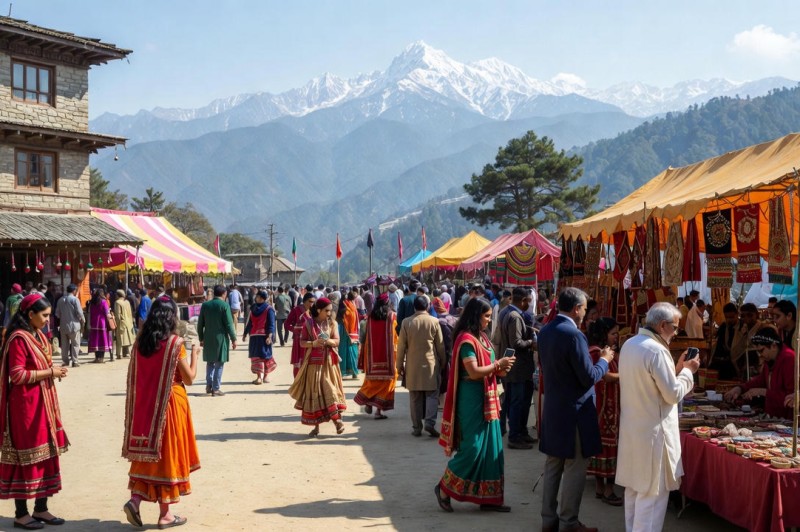35 secrets of Lord Shiva that you should know
thedivineindia.com | Updated UTC time: 2023-07-03 01:25:22
Lord Shiva, the God of Gods, Mahadev, who is known by the names of Bholenath, Adinath and Adidev, is 1008 names of Lord Shiva. There are 35 such secrets of Lord Shiva that you should know.
- Adinath Shiva - Shiva first tried to propagate life on earth, hence he is also called ‘Adidev’. The meaning of 'Adi' begins. Being Adinath, he also has a name 'Adish'.
- Shiva's weapons - Shiva's bow is Pinaka, Chakra Bhaverendu and Sudarshan, Astra Pashupatastra and Arms Trishul. All of the above were created by him.
- Lord Shiva's snake - The snake that is wrapped around Shiva's name is Vasuki. Vasuki's elder brother's name is Sheshnag.
- Shiva's Ardhangini - Sati's first wife Sati was born in the next life as Parvati and she is called Uma, Urmi, Kali.
- Shiva's sons - Shiva's chief 6 sons are Ganesh, Kartikeya, Sukesh, Jalandhar, Ayyappa and Bhuma. Most people only know Ganesh and Karthikeya. The story of the birth of all is interesting.
- Disciples of Shiva - There are 7 disciples of Shiva who have been considered as the early Saptarshi. These sages propagated the knowledge of Shiva throughout the earth, due to which different religions and cultures originated. Shiva started the guru and disciple tradition. Shiva has disciples - Brihaspati, Vishalaksha, Venus, Sahasraksha, Mahendra, Prachetas Manu, Bharadwaja, besides the 8th Gaurashiras Muni.
- Shiva's Ganaas - Bhairava, Veerabhadra, Manibhadra, Chandis, Nandi, Shringi, Bhrigirity, Shail, Gokarna, Ghantakarna, Jai and Vijay are prominent among Shiva's Ganas. Apart from this, vampires, demons and serpent-serpents, animals are also considered as the Gan of Shiva.
- Shiva Panchayat - Lord Surya, Ganapati, Devi, Rudra and Vishnu are called Shiva Panchayats.
- Shiva's Gatekeepers - Nandi, Skanda, Riti, Vrishabha, Bhringi, Ganesh, Uma-Maheshwar and Mahakal.
- Shiva Councilor - Just as Jai and Vijay are the councilors of Vishnu, in the same way Bana, Ravana, Chand, Nandi, Bhringi etc. are the councilors of Shiva.
- The center of all religions is Shiva - The costumes of Shiva are such that people of every religion can find their symbols in them. In Mushrik, Yazidi, Sabiin, Subi, Ibrahimi religions, the impression of Shiva's presence can be clearly seen. A tradition started from the disciples of Shiva, which later divided into Shaiva, Siddha, Nath, Digambara and Sufi sects.
An international scholar, a practicing scholar, penetrating Buddhist literature, believes that Shankar was born as a Buddha. He mentioned the 27 Buddhas mentioned in the Pali texts and said that among them the three names of Buddha are very ancient - Tanankar, Shankar and Meghankar. - Beloved Shiva both Devata and Asura - Lord Shiva is worshiped along with Devas by demons, demons, demons, vampires, Gandharvas, Yakshas etc. He gives boon to Ravana as well as Rama. He had given boons to many demons like Bhasmasura, Shukracharya etc. Shiva is the supreme deity of all tribal, vanvasi caste, varna, religion and society.
- Shiva Icon - The mark that all ordinary people, from the forest dwellers, can worship, the lump of stone, is considered to be the sign of Shiva. Apart from this, Rudraksh and Trishul are also considered to be the sign of Shiva. Some people also consider Damru and Ardh Chandra as the sign of Shiva, though most people worship Shivalinga i.e. the light of Shiva.
- Shiva's cave - Shiva built a cave with his trident in a hill to escape from Bhasmasura and they then hid in the same cave. The cave is on the hills of Trikuta, 150 km from Jammu. On the other hand, the cave where Lord Shiva imparted the nectar of knowledge to Parvati is famous as the Shamarnath cave.
- Shiva's Footprints - Shreepad- Shiva's footprints are in the temple called Shreepad located on the top of Ratan Island mountain in Sri Lanka. These footprints are 5 feet 7 inches long and 2 feet 6 inches wide. This place is called Sivanolipadam. Some people call it Adam's Peak.
- Rudra Padas - The temple of Srisvedaranyeshwar in Thiruvengadu area of Nagapattinam district of Tamil Nadu has the footprint of Shiva known as Shudra Padamash. Apart from this, there is a footprint of Shiva at one place in Thiruvannamalai.
Tezpur - Shiva's right foot footprint in the Rudrapad temple located near the Brahmaputra River in Tezpur, Assam.
Jageshwar - Shiva's footprint near the temple of Bhima in the forest, about 4 and a half kilometers from the hill of Jageshwar Temple, 36 km from Almora in Uttarakhand. To avoid having darshan of the Pandavas, he put one foot here and the other in Kailash.
Ranchi - Shivji has footprints on Shranchi Hill, 7 kilometers from Ranchi railway station in Jharkhand. This place is called Shapahadi Baba Mandirsh. - Incarnations of Shiva - Veerabhadra, Pippalad, Nandi, Bhairava, Mahesh, Ashwatthama, Sharabhavatar, Grihapati, Durvasa, Hanuman, Taurus, Yatinath, Krishnadarshan, Avadhoot, Bhikshuvarya, Sureshwar, Kirat, Sunnataraka, Brahmachari, Yaksha, Vaishyanath, Dwijeshwar, Hansarupa, Dwij, Nateshwar etc. have taken place. The Vedas mention Rudras. Rudra 11 is told - Kapali, Pingal, Bhima, Virupaksha, Vilhoit, Shasta, Ajapada, Aapirbudhya, Shambhu, Chand and Bhava.
- Shiva's paradox family - Shivaputra Karthikeya's vehicle is Mayur, while Shiva has Vasuki Nag on his neck. By nature, Mayur and Nag are enemies among themselves. Here Ganpati's vehicle is a rat, while the snake is a rodent. Parvati's vehicle is a lion, but Shivji's vehicle is a Nandi bull. Despite this contradiction or ideological difference, there is unity in the family.
- He lives on Mount Kailash in Tibet. Just below the mountain where Shiva is seated is the Hades, the place of Lord Vishnu. Across the atmosphere above the seat of Shiva is the place of heaven and then Brahmaji respectively.
- Shiva devotee - Lord Rama and Krishna including Brahma, Vishnu and all the deities are also Shiva devotees. According to Harivamsa Purana, Krishna did penance on Mount Kailas to please Shiva. Lord Rama worshiped him by establishing a Shivalinga at Rameswaram.
- Shiva Meditation - Shiva is worshiped for devotion to Shiva. By offering bilvapatra to the Shivling, chanting or meditating near the Shivling, the path of salvation is confirmed.
- Shiva Mantra - There are only two Shiva mantras. First- Om Namo Shivaaya. The second Mahamrityunjaya mantra - tryambakaṃ yajāmahe sugandhiṃ puṣṭivardhanam
urvārukamiva bandhanānmṛtyormukṣīya mā'mṛtāt. - Shiva fasts and festivals - Shiva fasts are kept on Mondays, Pradosh and Shravan month. Shivaratri and Mahashivratri are the major festival of Shiva.
- Shiva Preacher - The tradition of Lord Shankar was carried forward by his disciples Brihaspati, Vishalaksha (Shiva), Venus, Sahasraksh, Mahendra, Prachetas Manu, Bharadwaja, Agastya Muni, Gaurashiras Muni, Nandi, Karthikeya, Bhairavnath etc. Apart from this, Veerabhadra, Manibhadra, Chandis, Nandi, Shringi, Bhrigirity, Shail, Gokarna, Ghantakarna, Baan, Ravana, Jai and Vijay also propagated Shaivism. The biggest name in this tradition comes from Adiguru Lord Dattatreya. After Dattatreya, the names of Adi Shankaracharya, Matsyendranath and Guru Guru Gorkhanath are taken prominently.
- Shiva Glory - Shiva drank poison called Kalkut which came out during Amrit Manthan. Shiva gave boons to many demons like Bhasmasura. Shiva had consumed Kamdev. Shiva united the head of Ganesha and King Daksha. Shiva cut off the fifth head of Brahma when he was tricked by Brahma.
- Shaivite tradition - Dasnami, Shakta, Siddha, Digambara, Nath, Lingayat, Tamil Shaivite, Kalmukh Shaivite, Kashmiri Shaivite, Veerashaiva, Naga, Lakulish, Pashupat, Kapalik, Kaladaman and Maheshwar are all from Shaiva tradition. Chandravanshi, Suryavanshi, Agnivanshi and Nagvanshi are also considered by the tradition of Shiva. Shiva is the adorable god of the Asura, Raksha and tribal caste of India. Shaivism is the religion of the tribals of India.
- Major names of Shiva - There are many names of Shiva in which 108 names are found in Puranas, but know the names here- Mahesh, Neelkanth, Mahadev, Mahakal, Shankar, Pashupatinath, Gangadhar, Natraj, Trinetra, Bholenath, Adidev, Adinath , Trimbak, Trilokesh, Jatashankar, Jagdish, Pralayankar, Vishwanath, Vishveshwara, Hara, Shivshambhu, Bhootnath and Rudra.
- Amrit Nath of Amarnath - There are many branches of knowledge that Shiva gave to his Goddess Parvati in the cave of Amarnath for salvation. He is involved in the basic formulas of Gyan Yoga and Tantra. Svigyan Bhairava Tantrasha is one such book, which contains a compilation of 112 meditations on Lord Shiva told to Parvati.
- Shiva Granth - Including Vedas and Upanishads, Vigyan Bhairava Tantra, Shiva Purana and Shiva Samhita encompasses the complete education and initiation of Shiva. His teachings have expanded in many texts of Tantra.
- Shivalinga - According to Vayu Purana, in the Holocaust, all creation which gets absorbed and which appears in the reincarnation period is called Linga. In this way, the entire energy of the world is the symbol of gender. This whole universe is a point-sound form. The point is Shakti and Nad Shiva. Point means energy and sound means sound. This is the basis of two whole universe. For this reason, worship of Shivling is a symbol.
- Twelve Jyotirlingas - Somnath, Mallikarjuna, Mahakaleshwar, Omkareshwar, Vaidyanath, Bhimshankar, Rameshwar, Nageshwar, Vishwanathji, Trimbakeshwar, Kedarnath, Ghrishneshwar. There are many beliefs regarding Jyotirlinga origin. Jyotirlinga means Shwyapak Brahmatalingash which means Shwipak Prakash. Which are the twelve sections of Shivalinga. According to Shivpuran, Brahma, Maya, Jiva, Mind, intellect, mind, ego, sky, air, fire, water and earth are called Jyotirlinga or Jyoti Pind.
According to the second belief, according to the Shiva Purana, in ancient times, light objects fell from the sky and light spread from them for a while. Many such meteor bodies fell from the sky to the earth. Of the many bodies that have fallen in India, the main twelve are included in the Jyotirlinga. - Shiva's Darshan - Those who see Shiva's life and philosophy with real vision are Shiva devotees with the right intelligence and catching the reality, because Shiva's philosophy says live in reality, live in the present, do not fight with your mind, Look at them as strangers and also use imagination for reality. Before Einstein, Shiva had said that imagination is more important than knowledge.
- Shiva and Shankar - Shiva's name is associated with Shankar. People say- Shiva, Shankar, Bholenath. In this way, many people inadvertently call Shiva and Shankar two names of the same power. Actually, the two statues are of different shape. Shankar is always shown as ascetic. In many places, Shankar is shown meditating on Shivalinga. Atru Shiva and Shankar are two different entities. However Shankar is also considered as a form. Mahesh (Nandi) and Mahakal are believed to be the gatekeepers of Lord Shankar. Rudra is a member of the Panchayat of God Shankar.
- Mahadev, the God of Gods - used to compete with the demons of the gods. In such a situation, whenever the Gods were in severe trouble, they all went to Devadhidev Mahadev. Gods including demons, demons also challenged Shiva many times, but they all vanquished and bowed to Shiva, therefore Shiva is Mahadev, the god of the gods. He is also the beloved God of demons, demons and ghosts. He gives boon to Rama as well as Ravana.
- Shiva in every era - Lord Shiva has given darshan to people in every era. Shiva was also there during the time of Rama. There was Shiva even in the Mahabharata period and there is a mention of Shiva's darshan in the time of Vikramaditya. According to Bhavishya Purana, Lord Shiva also appeared to King Harshavardhana….
Shiv Related Aritcles in Hinduism

